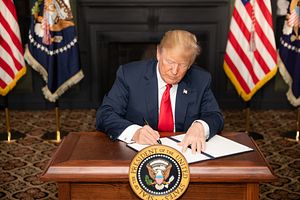There is little doubt that the most consequential geopolitical event this year is the ongoing trade war between China and the United States. A full-blown trade war between the two largest economies in the world is already in place with the most recent round of tariffs, with the United States imposing another $200 billion worth on Chinese goods and China retaliating with a $60 billion round on U.S. goods. Various analysts and commentators have hotly debated who will win the trade war and the impact of it on the global economy, but there is no consensus on the winner yet, mainly because different analysts look at different indicators.
One obvious reason that there is no winner yet is that we’re still in the early days of the trade war. In other words, there is not enough time or economic data to truly assess the impact of the trade war on both economies as the real trade war only started in early July. This will change when more economic data becomes available by the end of this year.
Even one economic indicator that U.S. President Donald Trump loves to quote in his tweets — the U.S. stock market index — tells a more complex story. It is true that China’s stock market has performed badly this year, but that is a result of multiple factors such as a weak economy, stricter regulations, and crunched money supply. The market did plunge a bit after the trade war started in July, but recently the market has picked up somewhat despite the most recent $200 billion tariffs on China. Moreover, as scholars at the Council on Foreign Relations point out, Trump makes a mistake by looking at the two stock markets instead of individual stocks that are actually affected by trade tariffs. Looked at this way, the trade war is actually hurting both the U.S. economy and Chinese economy equally, more or less consistent with mainstream economic analysis.
A more important indicator, perhaps, is the stated policy goals of the trade war. So far, the Trump administration has sent out sometimes confusing signals as to what it really wants to achieve with a trade war with China. The following objectives have been suggested at various times: reducing the trade deficit with China (this seems to be Trump’s personal goal), stopping the “Made in China 2025” project, opening up China’s market, stopping China’s intellectual property rights violations, changing China’s state capitalist system, and, finally, stopping China’s rise. Since the objectives are so broad, it is difficult for the United States to focus on one battle at one time. This is especially the case because China has decided to fight back and made preparations for a prolonged war and there is little evidence to suggest that China would be willing to comprise much in the short run. In the words of Chinese officials, China will not give in with a knife at the throat. And ironically, the U.S. trade deficit, the indicator Trump seemingly cares so much about, has in fact widened in recent months and the trade deficit with China widened too. No wonder Trump in recent months no longer talks about his winning on the trade deficit with China. As exporters ship goods out of China to the United States in anticipation of more tariffs, the trade deficit number might become bigger by the end of this year. If so, that is clearly a failure on the part of Trump since he wanted so badly to reduce the number.
Other objectives such as stopping the “Made in China 2025” project and changing China’s economic system are even more difficult for the United States. It might be true that China recently has turned down its emphasis on Made in China 2025, but that doesn’t mean China has decided to abandon the project. Even China’s most recent measures of market opening up can be seen as part of its original plans, at most facilitated along at an earlier date by the trade war with the United States. As the Chinese government has emphasized multiple times, China will decide the scope and pace of opening up in accordance with its own domestic interests and conditions.
So, even by the most obvious economic indicators, the United States is not winning the trade war with China, at least not right now. But this doesn’t mean China is winning either. Both economies will suffer if the trade war further escalates and spreads into other areas, especially the security area. The U.S. government clearly wants to have a fierce competition with China, and this is fine as long as competition does not become outright confrontation. Things do not look bright at the moment as the Trump administration is ready to roll out a “holistic squeezing” strategy toward China. If not managed carefully by both sides, this fierce competition might drag the whole world into a new type of great power conflict.

































